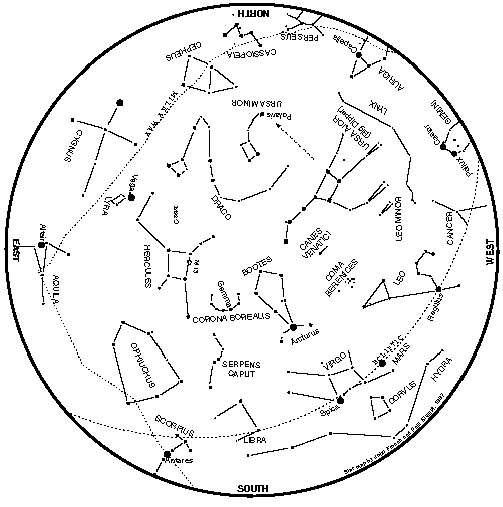
Four planets are visible in the night and early morning skies during May and June, and identifying them takes just a little knowledge and practice. Once you have spotted a planet, and follow it from month to month, you will come to know it well. A good way to start is to use the moon as your guide. If the sky is clear, then most often the brightest object near the moon is the planet in question. For example, the moon is quite close to Mars on four evenings during May and June.
In addition, bright planets do not "twinkle" like stars do. Stars twinkle because, being so far away, they are effectively pinpoints of light, and Earth's atmospheric turbulence causes them to twinkle. Planets, on the other hand, are much closer to Earth than stars are. Their surfaces can be seen even through small telescopes. Because they have a finite size in the sky, they are not as affected by atmospheric turbulence as stars are, and so they seem to glow more steadily. This subtle quality of the light from planets will help you to identify them.
Finally, from week to week, planets will appear to move relative to the background stars. The word "planet" comes from the Greek meaning "wanderer."
Look for these planets during May and June:
Venus is a brilliant object visible in the west 30 minutes after sunset from late May onwards. Look for Venus to the right of a crescent moon on the evening of June 6. As the month passes, Venus will climb higher in the evening sky as its orbital path takes it farther from the Sun from our perspective on Earth.
Mars is an orange object high in the southwest after sunset, as bright as the brightest stars in the sky. The moon lies near Mars on May 15 and 16, and June 11 and 12. On July 4, a NASA spacecraft will land on Mars, the first to do so in 21 years.
Jupiter can be seen low in the southeast well after midnight. A pair of binoculars mounted on a tripod will help you to see some of the moons of Jupiter-tiny star-like points that change their relative positions every few hours. Currently the Galileo spacecraft is orbiting Jupiter and sending back stunning pictures of these moons. See them on the world wide web at http://www.jpl.nasa.gov/galileo.
Saturn is visible high in the southeast before sunrise. The waning crescent moon passes close to Saturn on May 31 and June 28. A small telescope will show the rings of Saturn-always a spectacular sight.
Now showing at the Science Center's Henry Buhl, Jr. Planetarium is Comet: From Ice to Fire. The show captures amazing images of Comet Hale-Bopp, which was visible over the past few months. Every Friday at 4:00 p.m. the planetarium presents Stars Over Pittsburgh, your weekly guide to the current night sky.

Find a dark observing site, away from bright street lights and porch lights. You should also give your eyes time to adjust to the darkness. To avoid hampering your night vision and give yourself just the right amount of light for reading the map, place a small brown paper bag over a flashlight.
If you don't know which direction you're facing, look for the Big Dipper, or Ursa Major. Then follow the two stars at the end of the dipper's bowl across the sky to the north star, or Polaris, and you will be facing north. East is to your right, west is to your left and south is behind you.
When you look at this map, you might think that east and west are reversed. They are opposite from the directions on a road map, but when you hold the star map over your head and look up at it, east and west fall into place. The stars on the map now should match the stars in the sky.
The north star is the only star in the sky that never moves. Throughout the night and year, all the stars move in circles around Polaris, also called the "pole star" since it is located directly over the Earth's north pole.
As the night progresses, the stars will slowly move from east to west, circling around the pole star due to the Earth's rotation. Because the Earth is also moving around the sun, the stars appear a bit farther to the west at the same time each night. Therefore, the times to use this map are: May 1, 11:00 p.m.; May 15, 10:00 p.m.; May 31, 9:00 p.m.; June 15, 8:00 p.m.; June 30, 7:00 p.m.
Martin Ratcliffe directs the Henry Buhl, Jr. Planetarium and writes a monthly column for Astronomy magazine. Star charts are designed by Paul Stumph, a planetarium volunteer.